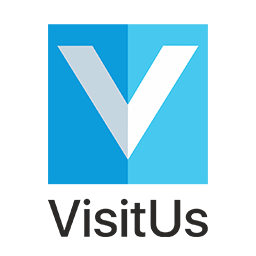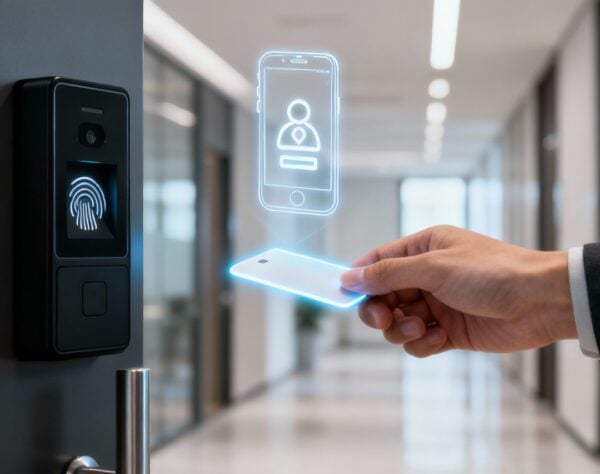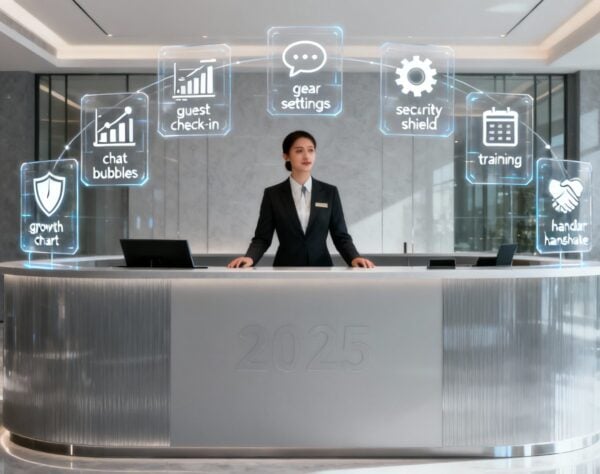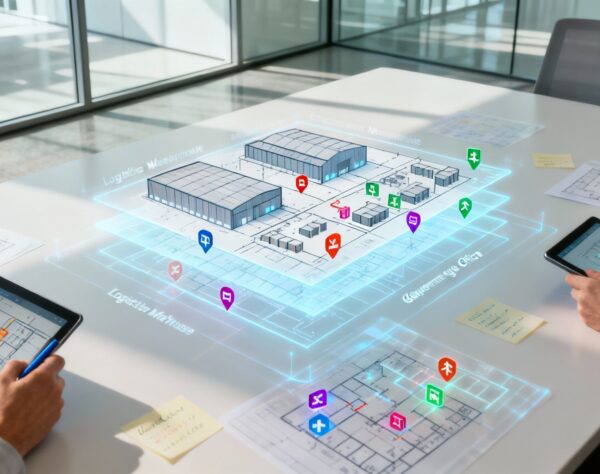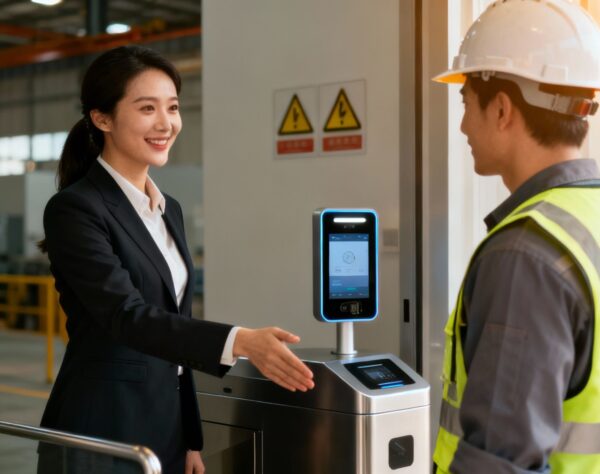
A Guide to Your Visitor Management System
A modern visitor management system answers one critical question: 'Who is on our premises, and are they supposed to be here?' It’s a strategic tool that automates and secures how you welcome, monitor, and manage every guest, replacing insecure paper logbooks for good and creating a safer, more professional environment.
Beyond the Logbook: The Benefits of a Modern Welcome
The traditional paper sign-in sheet, once a reception staple, is now a significant liability. In a world with heightened security risks and complex compliance rules, it offers zero real-time visibility, is prone to errors, and leaves sensitive visitor data exposed.
This is where a modern visitor management system delivers immediate benefits. An old logbook is a static record of arrivals. A digital system is a live, dynamic GPS for your building, providing an accurate and secure overview of everyone on-site at any moment.
The Shift to Smarter First Impressions
The move from paper isn't just about technology; it's driven by tangible business needs. Manual processes are slow and costly. In fact, studies show operational inefficiencies can cost companies up to 30% of their annual revenue. A visitor management system directly tackles this by automating repetitive front-desk tasks, creating a chain reaction of benefits. The advantages focus on three key pillars:
- Enhanced Security: Knowing exactly who is on-site is the foundation of workplace safety. A visitor management system provides real-time tracking and can screen visitors against watchlists, creating a solid audit trail for every entry and exit. A recent survey revealed that 41% of organizations lack confidence in knowing who is in their buildings, a critical gap a digital system closes instantly.
- Streamlined Efficiency: Imagine visitors pre-registering before they arrive and their host receiving an instant notification upon check-in. This eliminates lobby bottlenecks and drastically cuts visitor wait times, boosting productivity for everyone.
- A Superior Visitor Experience: A quick, professional, and secure check-in process makes a fantastic first impression. It signals that you value your visitors' time and take their safety seriously, reflecting positively on your entire business.
A well-implemented visitor management program isn't just an admin tool; it's a critical part of a company's overall risk management and security strategy, providing the data and control needed to protect people, property, and information.
Building a Foundation of Trust and Safety
Ultimately, implementing a visitor management system creates a safer, more professional, and compliant environment. It’s a proactive step to meet modern challenges. By ditching the paper logbook, businesses gain a complete and accurate picture of who is in their building at all times—essential for everything from daily operations to emergency evacuations. This transforms the reception area from a simple entryway into a vital control point for your facility's security and success.
Unlocking Core Business Benefits with a Visitor Management System
Moving past a pen-and-paper logbook delivers real, tangible value that strengthens your entire organization. A modern visitor management system is a powerful engine driving improvements across three core business pillars: security, compliance, and operational efficiency. These benefits work together to create a workplace that’s safer, more professional, and far more productive.
This infographic shows just how much a sleek, modern kiosk can transform your reception area from a point of friction into a hub of security and efficiency.
As you can see, the jump from a cluttered paper-based desk to a clean, automated solution elevates the entire visitor experience while tightening up your security protocols.
To really see the difference, let's compare the old way with the new.
Comparing Manual Logbooks vs. Digital Visitor Management Systems
This table highlights the key differences between traditional visitor tracking methods and a modern digital VMS across critical business areas.
| Area of Impact | Manual Logbook | Digital Visitor Management System |
|---|---|---|
| Security | Minimal. Easy to forge, hard to read, and provides no real-time data. Relies on human oversight. | High. Real-time tracking, watchlist screening, and photo capture. Creates an instant, accurate emergency list. |
| Compliance | Difficult. Records are often incomplete, insecure, and a nightmare to search through for an audit. | Automated. Securely stores data, generates audit-ready reports in seconds, and enforces NDAs or safety briefings. |
| Efficiency | Low. Creates front-desk bottlenecks, requires manual data entry, and offers no host notifications. | High. Automates check-in/out, sends instant notifications, and allows for pre-registration to speed up arrival. |
| First Impression | Outdated. A messy, paper-filled desk can look unprofessional and disorganised. | Professional. A sleek kiosk with custom branding creates a modern, welcoming, and secure first impression. |
The contrast is stark. A digital system isn't just a minor upgrade; it's a fundamental shift in how you manage your premises.
Fortify Your Facility Security
The primary benefit businesses experience is an immediate and dramatic improvement in workplace security. A VMS acts as a digital gatekeeper, providing a crystal-clear, real-time log of every person on your premises. In an emergency, first responders need to know exactly who they are looking for. A digital system provides an instant, accurate list of all visitors, accessible from any device—a benefit that can genuinely save lives.
Beyond emergencies, a VMS helps prevent unauthorized access by screening visitors against internal watchlists, flagging potential risks before they step past reception. It turns your front door into your first line of defense.
By providing a verifiable audit trail of every visitor—who they were, when they arrived, who they met, and when they left—a digital system creates a level of accountability that paper logs can never match.
Simplify and Automate Compliance
Meeting regulatory standards can be an administrative burden. A visitor management system automates much of this process, making audits less stressful and ensuring you meet legal obligations. Many industries have strict rules about data privacy and facility access. A VMS creates an irrefutable digital record, proving you’re following these protocols. These secure, searchable records save time and cut the risk of human error that could lead to costly fines. You can explore a deeper dive into the benefits of a visitor management system to see how this plays out across different sectors.
Boost Your Operational Efficiency
A visitor management system delivers a serious boost to daily operations by eliminating queues and manual tasks. Automating the check-in process frees reception staff from repetitive data entry, allowing them to focus on more valuable, human-centric work. As operational inefficiencies can cost companies up to 30% of their revenue each year, streamlining the front desk is an excellent place to start recouping those losses.
This efficiency extends to visitors and employees. Guests can pre-register for a seamless check-in, while instant host notifications mean your team isn't left wondering if their meeting has arrived. The entire process becomes smooth and professional, reflecting well on your brand.
Capabilities That Create Real Business Value

A modern visitor management system isn’t defined by technical specs but by its ability to solve real-world business problems. It’s about turning capabilities into outcomes that make your workplace safer, more efficient, and more professional. This is why the global visitor management system market, valued at around USD 1.8 billion, is projected to reach USD 6.9 billion. This growth is driven by tougher regulations and a greater focus on physical security.
Create a Seamless Arrival Experience
A major benefit is enabling visitors to pre-register before they arrive. This single capability transforms their first impression. Instead of juggling pens or tapping details into a kiosk, guests receive an invitation link. They can fill in their details, sign an NDA, or watch a safety video from their own device. Upon arrival, a quick QR code scan is all it takes to check in, creating a VIP experience that shows you respect their time.
Eliminate Front-Desk Bottlenecks
Once a visitor checks in, the system automates communication. Instant host notifications are a perfect example. The moment a guest arrives, their host gets an automatic alert via SMS, email, or a direct message in Slack or Microsoft Teams. This direct communication delivers significant benefits:
- Slashes Visitor Wait Times: Guests are greeted promptly, improving their experience.
- Frees Up Reception Staff: Your front-desk team can focus on higher-value tasks.
- Improves Employee Productivity: Staff manage their time better without unnecessary interruptions.
This simple automation smooths out the entire arrival process, ensuring visitors get where they need to go without friction.
Tailor Workflows for Every Visitor Type
Not all visitors are the same, so their check-in process shouldn't be either. A key benefit of a digital system is creating custom workflows for different visitor types, ensuring you collect the right information from the right people. For example, an interview candidate might only need to provide their name, while a contractor might need to:
- Upload a copy of their trade license or insurance.
- Complete a detailed safety induction.
- Acknowledge specific on-site hazards before gaining access.
This customization helps you stay compliant and secure without burdening every guest with irrelevant steps. If you want to dive deeper into these kinds of features, check out our guide on the must-have visitor management system features.
A crucial part of any modern system is solid data synchronisation. It ensures all your information—like employee lists and visitor logs—is perfectly aligned across all platforms, making features like host notifications and accurate reports possible. For anyone curious about the tech, understanding data synchronization is a great place to start.
Turn Visitor Data into Actionable Insights
Finally, a visitor management system is a goldmine of data. Every check-in and check-out creates a detailed digital record that you can search in seconds. This isn't just about knowing who was in the building. With built-in reporting, you can analyze visitor traffic to determine optimal reception staffing levels or pull compliance reports for a security audit with a few clicks. This data provides the hard evidence needed to make smarter facility decisions and prove you’re running a secure operation.
How to Implement Your New System Successfully
Rolling out a new visitor management system should be a smooth transition that delivers immediate value. The key to a successful launch is a clear plan. With the right approach, you can achieve rapid adoption and see a return on your investment from day one. The process begins by identifying your specific needs, considering your daily visitor volume, security risks, and any industry compliance rules you must follow. A 2024 report pegged the average cost of a data breach at $4.88 million, underscoring the importance of selecting a system that aligns with your data security and compliance requirements.
Choosing the Right Solution for Your Business
Once you understand your requirements, focus on the benefits that will make a real difference to your organization. Look beyond the sales pitch and evaluate potential providers on a few key criteria that will determine long-term success:
- Integration Potential: Can the system connect with your existing tools, like your employee directory or access control? Seamless integration eliminates data silos and automates workflows.
- Scalability: Will the system grow with your business? Ensure it can handle more locations or increased visitor traffic without a dramatic price jump.
- Quality of Customer Support: When you need help, is there a responsive team ready to assist? Check reviews and ask about their support channels and response times.
A successful implementation isn’t just about the technology. It’s about choosing a partner who understands your needs and is committed to helping you achieve your goals.
Ensuring a Frictionless Setup and Launch
With the right solution selected, the next step is the physical setup and staff training. Modern, cloud-based systems are designed for quick and easy deployment, often getting you up and running in a very short time. For a full walkthrough, our guide on setting up a visitor management system in under 30 minutes provides practical, step-by-step instructions.
Effective staff training is just as critical. Your front-desk team are the champions of this new system, so they need to feel confident using it. Provide clear guides and hands-on training. More importantly, demonstrate how the system makes their jobs easier—by automating notifications and eliminating messy logbooks—to win their enthusiastic support.
Measuring Success and Proving ROI
The final step is tracking your results to demonstrate a clear return on investment. Before you go live, benchmark your current performance. Then, track the changes in these key areas to quantify the benefits:
- Reduced Check-in Times: Measure the average time a visitor spends signing in. A significant drop demonstrates improved efficiency and a better visitor experience.
- Improved Audit Readiness: Track how quickly you can generate compliance reports. Reducing this from hours or days to seconds is a powerful metric.
- Front-Desk Workload Reduction: Survey your reception staff to quantify the time saved on administrative tasks, which can now be reallocated to higher-value work.
By monitoring these numbers, you can prove that your new visitor management system is a strategic asset that tightens security, boosts efficiency, and polishes your professional image.
What's Next for Visitor Management?
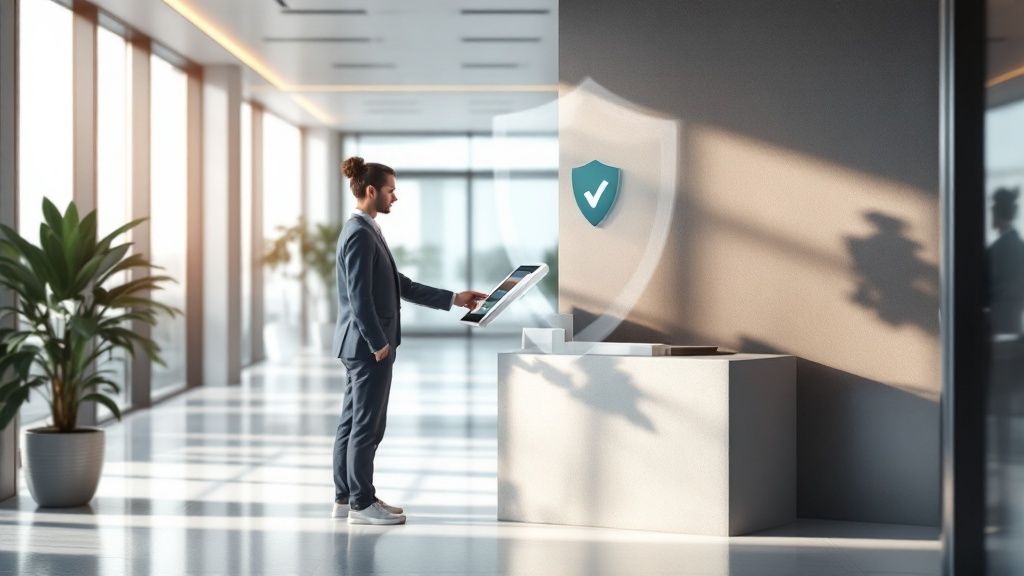
Workplace security and the visitor experience are constantly evolving, driven by new technology and changing expectations. The future of the visitor management system is about practical innovations that are building smarter, safer, and more connected workplaces today.
A major driver of this change is the shift to contactless check-in. This isn't just a response to health concerns; it's a fundamental improvement in operational smoothness. Visitors can now complete their entire registration on their mobile device, often before they arrive. This move to touch-free processes, including QR code scanning and pre-registration, creates a seamless journey while significantly enhancing safety protocols. You can explore more insights on the future of visitor management to see how these trends are taking shape.
The Rise of AI and Biometric Verification
As security needs grow more complex, artificial intelligence (AI) and biometrics are making identity checks faster, more accurate, and far more secure. This technology is already being used in high-security facilities. Imagine a system that verifies a contractor's identity by comparing a live photo against their government-issued ID in seconds. This automation removes the risk of human error and adds a powerful layer of security.
This technology is transforming the VMS from a simple logbook into an active security partner, ensuring the person checking in is exactly who they claim to be.
The key benefits of this evolution include:
- Reduced Risk of Impersonation: Biometric data like facial recognition makes it nearly impossible for unauthorized individuals to gain access using false credentials.
- Faster Check-In Times: Automated verification is significantly quicker than manual ID checks, keeping visitor traffic flowing smoothly.
- Enhanced Audit Trails: The system creates a rock-solid, verifiable record of who was on-site and when, which is invaluable for compliance and incident investigations.
Becoming the Hub of a Smart Building
The most significant trend is the visitor management system's evolution into the central nervous system of a smart building. No longer a standalone tool, a modern VMS now integrates with a range of other building management and security systems to create a fully connected, intelligent environment. This connectivity unlocks powerful benefits. When a pre-registered visitor scans their QR code, the system can trigger a chain of events across other platforms.
For instance, this integration can trigger actions like:
- Access Control Integration: The VMS can instruct lifts or turnstiles to grant temporary access only to authorized areas.
- Meeting Room Coordination: It can notify the meeting room booking system that a guest has arrived, ensuring the space is ready.
- Emergency Notification Systems: In an evacuation, the VMS provides a real-time, accurate list of every visitor on-site to emergency response systems, ensuring everyone is accounted for.
This level of integration is a game-changer. The VMS is no longer just a gatekeeper; it’s an intelligent hub managing the entire visitor journey.
Frequently Asked Questions
Adopting new workplace technology often raises questions. When it comes to a modern visitor management system, it's natural to wonder about the practical side of things. This section tackles some of the most common queries with clear, straightforward answers. The good news? These systems are designed to solve problems, not create them.
Is a Visitor Management System Difficult to Install and Use?
Not at all. Modern visitor management systems, especially cloud-based solutions, are built to be incredibly user-friendly. The goal is to simplify your front desk, so an intuitive design is a top priority. Most systems use familiar devices like an iPad to guide visitors through a step-by-step check-in process. Installation is typically simple, requiring minimal IT support and getting you up and running quickly.
The core idea behind a quality VMS is to reduce complexity. Vendors usually provide detailed onboarding guides and training materials to ensure your team feels confident from day one.
The entire experience is designed to be seamless, meaning less confusion for guests and less troubleshooting for your staff.
How Does a VMS Improve Data Privacy and Compliance?
A digital VMS is one of the most effective tools for strengthening compliance and protecting sensitive information. Unlike a paper logbook left on a reception desk, it secures all visitor data digitally, restricting access to authorized personnel only. This is a crucial step toward complying with modern privacy laws. Considering the average cost of a data breach has soared to $4.88 million, secure data handling is more critical than ever.
A system can also be configured to automatically delete visitor data after a set period, ensuring your data retention policies are followed without manual intervention. Furthermore, it creates a detailed, time-stamped digital trail of every person who enters your facility—an invaluable log for security audits and demonstrating regulatory compliance.
Can This System Integrate with Our Existing Security Tools?
Yes, and this is a major benefit. Many modern visitor management systems are designed to connect seamlessly with other business and security software you already use. This integration creates a powerful, unified security posture, automating manual tasks and providing a clearer picture of on-site activity.
Some of the most valuable integrations include:
- Access Control Systems: To automatically grant temporary access via keycards or door codes for approved visitors.
- Employee Directories: Connecting to platforms like Active Directory ensures visitors can accurately select their host.
- Communication Tools: Instant notifications can be sent via apps like Slack or Microsoft Teams, so hosts know the second their guest arrives.
By linking these tools, a visitor management system becomes a central hub that improves security and boosts efficiency across your entire organization.
Ready to see how a modern, secure, and user-friendly visitor management system can transform your front desk? Discover how VisitUs creates a safer, more professional, and more efficient environment for your visitors, contractors, and staff. Explore VisitUs today!
